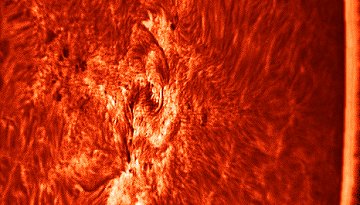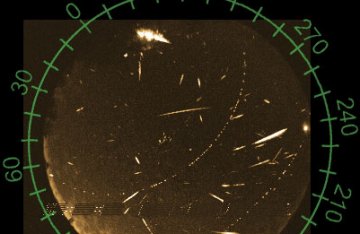 Where's Saturn? Is that a UFO--or the ISS? What's the name of that star? Get the answers from mySKY--a fun new astronomy helper from Meade. Where's Saturn? Is that a UFO--or the ISS? What's the name of that star? Get the answers from mySKY--a fun new astronomy helper from Meade. SUN BUZZ: The solar physics community is abuzz this week. No, there haven't been any great eruptions or solar storms. The source of the excitement is a modest knot of magnetism that popped up on the sun, possibly heralding the start of a new solar cycle: full story. SUNSPOT FAREWELL: Giant sunspot 978 is approaching the sun's western limb where it will soon disappear. Rogerio Marcon of Sao Paulo, Brazil, took this last minute shot using a Coronado SolarMax40: 
Sunspot 978 is decaying as it goes. Magnetic instabilities accociated with this process could hurl filaments and clouds of gas over the limb, making the days around its disappearance most entertaining. Stay tuned. more images: from the Langkawi National Observatory, Langkawi Island, Malaysia; from Howard Eskildsen of Ocala, Florida; from Franck Charlier of Marines, Val d'Oise - France; from S. Johansen, J. Fairfull and John Stetson of South Portland, Maine; SUBSIDING GEMINIDS: After two nights in a row of impressive flurries and fireballs, the Geminid meteor shower has finally subsided. Rates are now less than 10% of the 100+ per hour peak on Dec. 14th and 15th. In Guffey, Colorado, an all-sky camera operated by Chris Peterson captured 111 of the brightest meteors on Dec. 12th - 15th: 
"At least 65 are confirmed Geminids," says Peterson. "Several very bright fireballs are apparent, as well as the curved trails of Mars and Sirius." The Geminids of 2007 began on Dec. 13th less flamboyantly than expected, but the shower quickly developed into one of the best Geminid displays in years. According to the International Meteor Organization, counts under ideal dark-sky conditions reached 140 meteors per hour. Dec. 15th produced an extra helping of fireballs making the night after the predicted Dec. 14th peak visually best of all. 2007 Geminid Meteor Gallery
[World Map of Geminid Sightings]
[Geminid recap] [meteor alerts] [Night Sky Cameras] | 
